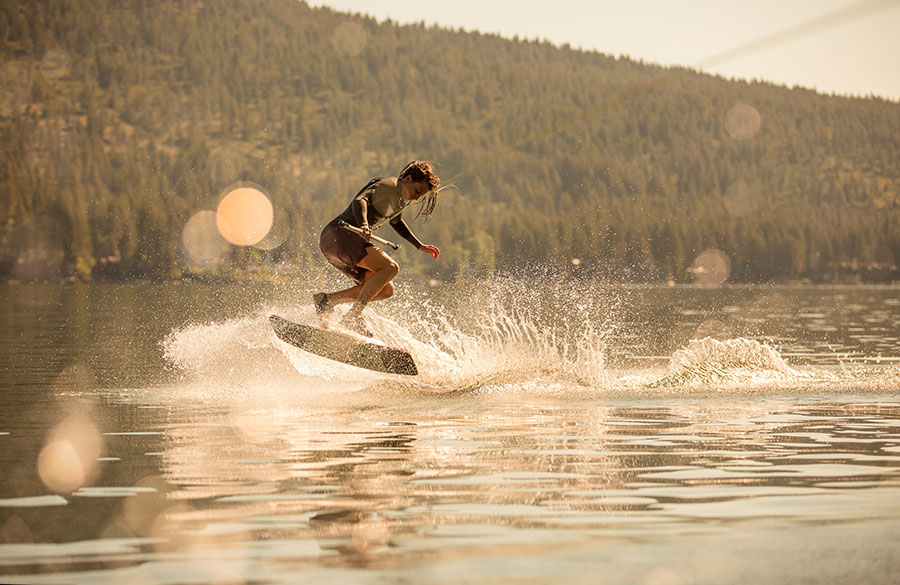By Sadie Maeda
It all started with an Instagram account. Frustrated by a lack of recognition for women in sports, filmmaker and author, Molly Schiot, started posting daily photos of less widely known sports heroines. The project served as a personal protest against the rampant sexism, racism, and prejudice in sports history but as Schiot dug deeper, she discovered a trove of forgotten and ignored women in sports.
25,000 followers later, Shiot got the opportunity of a lifetime to bring her project into hard cover history. In a collection of rarely before seen photos and stories, Schiot’s new book, Game Changers, sheds some light into a history of oppression for women in sports. The same stories that were hidden from the media, swept under the rug, or simply deemed “not interesting enough” are the same stories that are celebrated in this book. Included are also three featured interviews and what’s better than an interview with a sports icon? Two sport icons interviewing each other. Find out what happens when you get pro skateboarder, Lacey Baker, and Hall of Famer, Laura Thornhill talking about the changing industry or Abby Wambach and Title IX spearhead, Margaret Dunkie discussing equality.
Game Changers is a celebration of the women that broke down barriers, shattered glass ceilings, and all without any recognition or applause. They are the unsung heroines of our history and it’s about time their stories were told.
Here’s our interview with author, Molly Schiot and a exclusive snippet of one of the featured interviews!
What was your original inspiration for your Instagram account?
I started the Instagram account @theunsungheroines as a way to publicly streamline documentary ideas I pitched about women, that I was told at the time were not “interesting enough,” by networks. I loved being able to pull these names and faces from library archives and family albums and give them a small modern day, celebratory soap box.
What kind of responses from the public have you received?
Thankfully they have all been positive but the most humbling responses have been those where parents have been reading them to their young boys. I think it’s so COOL that a bunch of young boys are going to know who Junko, Wyomia, and Conchita are.
What female heroes inspired you when you were growing up?
I really didn’t have any sadly. My heroes were ALL dudes. Rocky, Karate Kid, Tony Alva, Wayne Gretzky, Axl Rose, etc… And that wasn’t my fault! Women were not represented, period. The only woman I was super inspired by was Joan Jett because I saw her once and awhile on MTV breaking down stereotypes in a way I had never seen.
What is your hope by bringing attention back to these unsung heroes?
The women in this book had the guts to be firsts – challenging racial, political, and cultural constructs that seemed impenetrable at the time. When a young girl sees a woman doing something it becomes attainable and key to changing perceptions. “I see a women running for president. I can be president.”
Out of all the women you’ve researched, what story touched you the most?
The story of Joe Carstairs is one of my all time favorites for so many reasons, but mostly because she was the ultimate badass. The photo is also one of my favorites. She was a championship motor boat racer who spent millions of dollars building and racing customized boats. She was the cigar smoking, tattooed heiress to the Standard Oil fortune. She preferred wearing men’s clothing. Her love life consisted of torrid affairs with Hollywood starlets like Marlene Deitrich and Tallulah Bankhead. Despite her many lovers, the only lasting object of her affection was a foot-tall leather doll named Lord Tod Wadley. Given to her by a girlfriend in 1925, Lord Wadley was her constant companion. She spoke of him as her dearest friend, dressing him in expensive tailored suits and ordering him tiny leather shoes from Italy. . . And still we are nearly at the beginning of the saga of Joe Carstairs. After facing tax problems in Britain and the U.S., Joe left civilization at the age of 34 and lived on a Bahamian Island called Whale Cay which she purchased for $40,000. She outfitted it with her own private Spanish villa, a schoolhouse, a power plant, a radio station, a museum dedicated to her own personal accomplishments and appointed herself the island’s official ruler, . She made laws — alcohol and adultery were banned, though she was exempt from this law — officiated marriages and births, named all of the children born on Whale Cay, created youth camps for the local residents, and ruled over the island with the help of a private machete-bearing militia. From the comfort of her villa, Carstairs continued to entertain a parade of gorgeous women and socialite friends well into her 70s. She kept a photograph of each woman she slept with, amassing around 120 pictures, but the women never stayed for long, as they were forbidden from spending the night in Carstairs’ bed. In 1975, disenchanted with island life, Carstairs sold the island for $1 million and moved to Miami where she lived the rest of her life tending to Lord Wadley and watching boxing shows on TV. She died in 1993 and was cremated and buried with Wadley by her side.
How do you think the stigma of female sports heroes have changed?
That’s a really hard question for me to answer because I don’t feel like it’s changed…..much.
What would you still like to see change for women in sports?
Recognition. Period. I would say that most women’s histories are unknown in general because we live in a patriarchal society where women traditionally have not been the ones telling the stories that people watch, read, or hear. This holds true for women in government, science, technology, and the industry I am enveloped by, entertainment. Out of the 160 ESPN 30 for 30 films, 5 of them are about women. That number is incredibly disheartening. These women’s stories have always been there and we need to ask why they are not being told.
How did the interview with Lacey Baker and Laura Thornhill come about?
My good pal Lauren Mollica said Lacey was the bees knees. Basically anything she says I’ll do. Laura, I had just met after scanning in a handful of photos for the book. I reached out to Laura because she was one of the most important OG’s and I had an immediate friend crush when I spoke to her on the phone. The two of them are so authentic. No weird stuff attached. It was straight up effortless harmony listening to them chat.
What do you think of skateboarding?
Skateboarding is one of those sports that has a certain sense of freedom attached. It triggers so much more than the typical emotion of athleticism. There is a music or a beat, maybe, that the sport has that sets it apart in a really beautiful way.
Why did you choose them to be apart of your three featured interviews?
Skate and surf history takes up space in the book and I wanted to honor that history with these two voices talking about the past and the present.
What’s your biggest takeaway from working on this project?
There was a quote that Janet Guthrie said in the New York Times piece about the book. She said “without recognition women lose their history.” I guess I simply want to recognize these women’s amazing accomplishments.
Who do you want to read/own this book?
Everyone 🙂
Lastly, what kind of advice would you give to women in sports who aren’t feeling heard or seen?
Tell them to find someone they look up to that’s accessible and reach out. Those people will respond. I promise.
Game Changers is available to buy on Amazon and makes a great Christmas gift for all the strong ladies in your life! You can check out more about the Unsung Heroines project on their website and make sure to follow them on Instagram! And below, you will find an exclusive sneak peek of the Lacey Baker and Laura Thornhill interview.
Laura Thornhill: How does your community support each other? Is it all women or are there men saying “hey, this is how it needs to be and we need to help you guys”?
Lacey Baker: Right now, I feel like it’s women that are supporting one another in that respect. It’s really just a small group of us. When we were in Norway , for example, after the X Games, my friend Kim pretty much organized and curated this whole event all on her own, just to reach out and get girl skaters to come together. We skated at the skate park on Friday and it was packed with little girl skaters and I was in awe that we could actually bring them together just by coming together ourselves and making it happen. Otherwise, there would be no community. We are in this space right now where can create so much visibility.
LT: I think there’s a huge movement going on with women being recognized. I think the opportunities are definitely growing. Cindy Whitehead is going an amazing things with “Girl is NOT a 4 Letter Word” and with her line of boards. Kim and Mimi and Cara-Beth are definitely pioneers in that area, especially Cara-Beth and Mimi, and Amelia now. There’s a continuation of women that are really trying to create this uprising of female empowerment and it’s great. There are so many girls skating all over the globe right now, so many more than ever before. Female skateboarding is huge. My friend Barb Odanaka has a thing called the Sisters of Shred and there’s this thing ever Mother’s Day called the Mighty Mama Skate-o-rama.
LB: It’s so crazy, Laura. Every other girl skater you just mentioned just now, I’ve never heard of. I wouldn’t know how to find out about them.
LT: There were girls. There were girls in the seventies and there were girls in that continued on into the eighties and nineties. How much notoriety that got or how many times there in the magazine, probably some of them have many placed in a contest here or there. Chances are they could never have been in a magazine. It was always a very small group of people who were even aware of their names.
LB: I think social media is changing how we find out about one another.
LT: Oh, absolutely.
LB: I have people almost every day reaching out through Instagram just being like “Hey, You’re great. You inspire me to skate.” I’m just like , holy hell, because it inspires me too, to keep skating.
LT: Do you think there is pressure on you to look a certain way from other skaters?
LB: In the community I’m in now, no.. Not at all. When we’re all together, we’re usually all together around contest times. We’re just all hanging out. The way we look does not matter. We’re all friends outside of skateboarding and that’s just something that really brings us together. I’ve met a couple of younger girls in the last two years and I feel like we’re gong to be friends for life and it’s not just about skating with them, bit’s connecting through skating. There is a huge solidarity. It’s really cool to be a part of it.
LT: Same. I never felt that. The girls weren’t being disrespected. The girls were being encouraged back when I was riding. The guys dug it. They weren’t like, you can’t ride this bowl. The girls were always given equal skating ground.
LT: How do you think the unfair prize money and sponsorship will change.
LB: I don’t know. Build our own industry and make it fair. That’s the idea I have. I feel like w’re all . . . For so long, it’s like, give the girls a contest. Give us something. Give us something, but then it’s like “Why don’t we just make our own thing and then we don’t have to ask”? When it comes down to just skating, If I was to skate with any of these guys who skate in the contest, sure, it’d be fun and awesome but it’s the industry that’s creating that. *



![[Skate] Mirroir – Female Skate Crew from China](http://d1musg6nna2c3e.cloudfront.net/2018/04/mirroir_female_skate_china_mahfia.jpg) [Skate] Mirroir – Female Skate Crew from China
[Skate] Mirroir – Female Skate Crew from China![[Skateistan] Land of Skate](http://d1musg6nna2c3e.cloudfront.net/2017/12/landofskate_thumb.jpg) [Skateistan] Land of Skate
[Skateistan] Land of Skate Real Talk Ep. 4 w/ Yulin Olliver
Real Talk Ep. 4 w/ Yulin Olliver Real Talk Ep. 3 w/ Zorah Olivia
Real Talk Ep. 3 w/ Zorah Olivia Real Talk Ep. 2 w/ Kristin Ebeling
Real Talk Ep. 2 w/ Kristin Ebeling Girls Skate Network
Girls Skate Network Mahfia Sessions
Mahfia Sessions Neon Stash
Neon Stash Longboard Girls Crew
Longboard Girls Crew Quit Your Day Job
Quit Your Day Job The Flipside: Timeless Areas with Elissa Steamer, Vanessa Torres, Alexis Sablone
The Flipside: Timeless Areas with Elissa Steamer, Vanessa Torres, Alexis Sablone Stop Drop and Roll 2018
Stop Drop and Roll 2018 NEFS Lizzie BOARDin Halloween Jam
NEFS Lizzie BOARDin Halloween Jam Exposure Skate 2017 by Olga Aguilar
Exposure Skate 2017 by Olga Aguilar 510 Shop Hangs x Skate Like a Girl SF Bay Fundraiser
510 Shop Hangs x Skate Like a Girl SF Bay Fundraiser![[Snow] Too Hard – PLUG [Snow] Too Hard - PLUG](http://d1musg6nna2c3e.cloudfront.net/2017/05/FI_snow_too_hard_plug.jpg) [Snow] Too Hard – PLUG
[Snow] Too Hard – PLUG![[Snow] Powanoia: Substance Formally Known as Powder [Snow] Powanoia: Substance Formally Known as Powder](http://d1musg6nna2c3e.cloudfront.net/2017/04/FI_snow_powanoia_teaser.jpg) [Snow] Powanoia: Substance Formally Known as Powder
[Snow] Powanoia: Substance Formally Known as Powder![[Snow] Too Hard G.O.A.T. – Christine Savage Full Part [Snow] Too Hard G.O.A.T. - Christine Savage Full Part](http://d1musg6nna2c3e.cloudfront.net/2017/02/FI_snow_too_hard_christine_savage_goat_full_part.jpg) [Snow] Too Hard G.O.A.T. – Christine Savage Full Part
[Snow] Too Hard G.O.A.T. – Christine Savage Full Part![[Snow] Foren Ep.2 – Intro to Tahoe [Snow] Foren Ep.2 - Intro to Tahoe](http://d1musg6nna2c3e.cloudfront.net/2017/02/FI_snow_foren_ep2.jpg) [Snow] Foren Ep.2 – Intro to Tahoe
[Snow] Foren Ep.2 – Intro to Tahoe![[JetPack] Lost in Space [JetPack] Lost in Space](http://d1musg6nna2c3e.cloudfront.net/2017/01/FI_snow_jetpack_lost_in_space.jpg) [JetPack] Lost in Space
[JetPack] Lost in Space PS Webisodes
PS Webisodes Vision Airs
Vision Airs Shredventures
Shredventures Too Hard
Too Hard The Progression Sessions Chile 2016
The Progression Sessions Chile 2016 B4BC’s 20th Anniversary Snowboard and Music Festival
B4BC’s 20th Anniversary Snowboard and Music Festival Introducing The Free Life Mag
Introducing The Free Life Mag Photographer Spotlight: Tucker Norred
Photographer Spotlight: Tucker Norred Photographer Spotlight: Nam-Chi Van
Photographer Spotlight: Nam-Chi Van![[Surf] Breaking Waves and Breaking Barriers with Brown Girl Surf [Surf] Breaking Waves and Breaking Barriers with Brown Girl Surf](http://d1musg6nna2c3e.cloudfront.net/2016/11/FI_skate_brown_girl_surf.jpg) [Surf] Breaking Waves and Breaking Barriers with Brown Girl Surf
[Surf] Breaking Waves and Breaking Barriers with Brown Girl Surf![[Surf] Kassia Meador & Kelia Moniz in Hainan Island, China [Surf] Kassia Meador & Kelia Moniz in Hainan Island, China](http://d1musg6nna2c3e.cloudfront.net/2016/07/FI_surf_Kassia_Meador_Kelia_Moniz_in_Hainan_Island_China.jpg) [Surf] Kassia Meador & Kelia Moniz in Hainan Island, China
[Surf] Kassia Meador & Kelia Moniz in Hainan Island, China![[Surf] Seea in Panama [Surf] Seea in Panama](http://d1musg6nna2c3e.cloudfront.net/2016/07/FI_surf_seea_in_panama.jpg) [Surf] Seea in Panama
[Surf] Seea in Panama![[Surf] Lunar by Onde Nostre [Surf] Lunar by Onde Nostre](http://d1musg6nna2c3e.cloudfront.net/2016/07/FI-surf-lunar-by-onde-nostre.jpg) [Surf] Lunar by Onde Nostre
[Surf] Lunar by Onde Nostre![[Surf] Summer Sun [Surf] Summer Sun](http://d1musg6nna2c3e.cloudfront.net/2016/07/FI-surf_summer_fun.jpg) [Surf] Summer Sun
[Surf] Summer Sun Leashless
Leashless Save Our Surf Fundraiser
Save Our Surf Fundraiser Brown Girl Surf Fundraiser Party 2016
Brown Girl Surf Fundraiser Party 2016 Photographer Spotlight: Kirstin Scholtz
Photographer Spotlight: Kirstin Scholtz![Ladies Night of Surfing [San Diego, CA] Ladies Night of Surfing](http://d1musg6nna2c3e.cloudfront.net/2015/12/ShaperStudios.12.4.15-6066.jpg) Ladies Night of Surfing [San Diego, CA]
Ladies Night of Surfing [San Diego, CA] Photographer Spotlight: Amanda Scarski
Photographer Spotlight: Amanda Scarski![[Moto] The Dream Roll [MOTO] The Dream Roll](http://d1musg6nna2c3e.cloudfront.net/2017/02/FI_moto_the_dream_roll.jpg) [Moto] The Dream Roll
[Moto] The Dream Roll![[BMX] Yeah Zine Trip 2012 [BMX] Yeah Zine Trip 2012](http://d1musg6nna2c3e.cloudfront.net/2016/12/FI_bmx_yeah_girl_2012.jpg) [BMX] Yeah Zine Trip 2012
[BMX] Yeah Zine Trip 2012![[Bike] “Herself” Short Film by SHE FIX](http://d1musg6nna2c3e.cloudfront.net/2016/10/FI_bike_herself_shefix.jpg) [Bike] “Herself” Short Film by SHE FIX
[Bike] “Herself” Short Film by SHE FIX![[BMX] Nina Buitrago and Dani Lightningbolt: Women At X Games [BMX] Nina Buitrago and Dani Lightningbolt: Women At X Games](http://d1musg6nna2c3e.cloudfront.net/2016/10/FI_bmx_nina_buitrago_dani_lightningbolt_women_in_the_xgames.jpg) [BMX] Nina Buitrago and Dani Lightningbolt: Women At X Games
[BMX] Nina Buitrago and Dani Lightningbolt: Women At X Games![[BMX] Concrete Surfing in Colorado [BMX] Concrete Surfing in Colorado | MAHFIA.TV](http://d1musg6nna2c3e.cloudfront.net/2016/08/FI_bmx_Concrete-Surfing-in-Colorado.jpg) [BMX] Concrete Surfing in Colorado
[BMX] Concrete Surfing in Colorado Specialized Women’s Let Her Rip at Crankworx 2016
Specialized Women’s Let Her Rip at Crankworx 2016 Woodward Tahoe Girls Week
Woodward Tahoe Girls Week![[Wake] Sherilyn Goes North [Wake] Sherilyn Goes North](http://d1musg6nna2c3e.cloudfront.net/2017/04/FI_wake_Sherilyn_Goes_North.jpg) [Wake] Sherilyn Goes North
[Wake] Sherilyn Goes North![[Wake] For The Girls [Wake] For The Girls](http://d1musg6nna2c3e.cloudfront.net/2017/03/FI_wake_for_the_girls.jpg) [Wake] For The Girls
[Wake] For The Girls![[Wake] “Luv My Dawgs And Dog” Edit By Melissa Marquardt [Wake] "Luv My Dawgs And Dog" Edit By Melissa Marquardt](http://d1musg6nna2c3e.cloudfront.net/2016/12/FI_wake_-Edit-By-Melissa-Marquardt.jpg) [Wake] “Luv My Dawgs And Dog” Edit By Melissa Marquardt
[Wake] “Luv My Dawgs And Dog” Edit By Melissa Marquardt MAHFIA Spotlight: Interview w/ Jen GilanFarr
MAHFIA Spotlight: Interview w/ Jen GilanFarr![[Wake] The Nordic Way with Carro Djupsjö [Wake] The Nordic Way with Carro Djupsjö](http://d1musg6nna2c3e.cloudfront.net/2016/08/FI_wake_The-Nordic-Way-with-Carro-Djupsjo%CC%88.jpg) [Wake] The Nordic Way with Carro Djupsjö
[Wake] The Nordic Way with Carro Djupsjö Quit Your Day Job
Quit Your Day Job Girlz Nite Out
Girlz Nite Out Girls Skate Network
Girls Skate Network Full Moon
Full Moon Longboard Girls Crew
Longboard Girls Crew Skateistan
Skateistan



![[Skate] Mirroir – Female Skate Crew from China](http://d1musg6nna2c3e.cloudfront.net/2018/04/mirroir_female_skate_china_mahfia-115x115.jpg)
![[Skateistan] Land of Skate](http://d1musg6nna2c3e.cloudfront.net/2017/12/landofskate_thumb-115x115.jpg)




